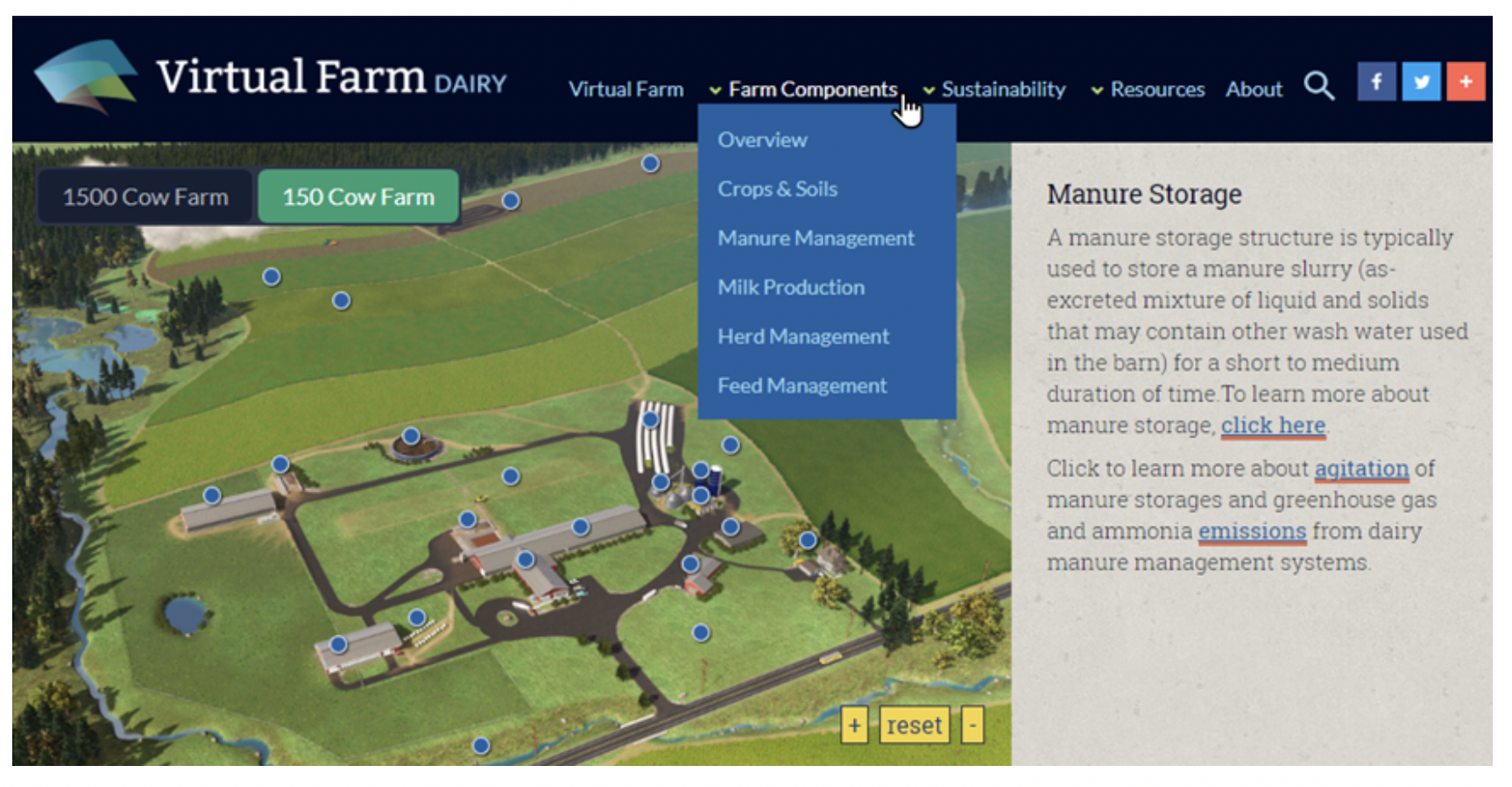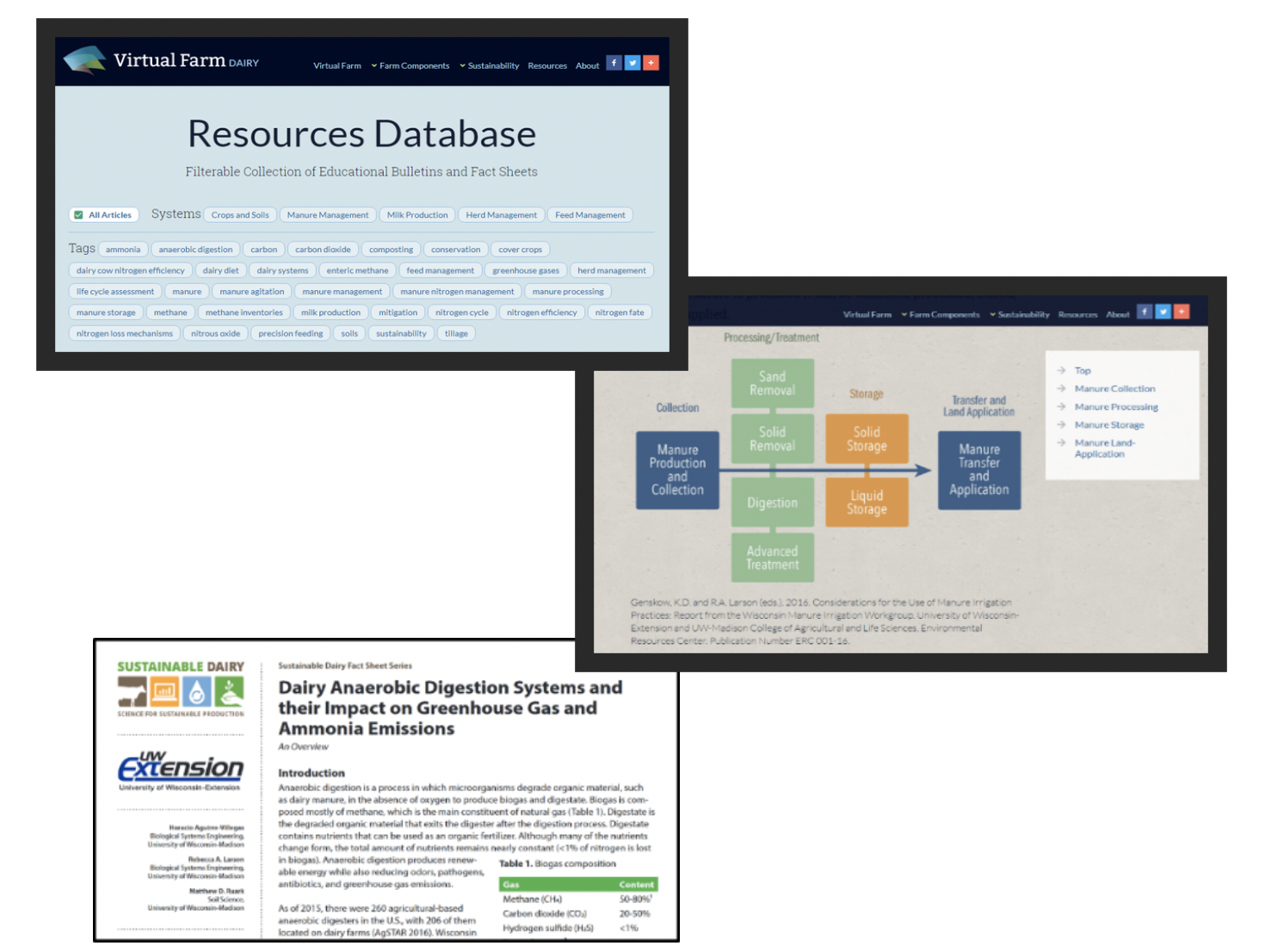 |
June 2020
|
June 2020 // Volume 58 // Number 3 // Tools of the Trade // v58-3tt6
Model Multilayered Website for Varied Audiences: Dairy Sustainability "Virtual Farm"
Abstract
A "virtual farm" website with science-based information about dairy sustainability topics was created for a variety of audiences. A key structure of the website is layering of information. At the most frequently used entry level, a site visitor explores by looking and learning. As interest evolves, the visitor finds links to technical levels, and those with a deep interest in a topic will find peer-reviewed documents at the research resource level. Process-based model scenarios include climate change mitigation practices targeted at dairies. Anecdotally, users have appreciated the professional looking access to technical information and depiction of modern dairy farming practices. Extension educators can use the site to inform themselves, for referral of clients, and as a model.
Introduction
A commitment to sustainable production and challenges from extreme weather events related to climate change have increased the need for easily accessible practical information for dairy farmers and their advisors. Mandal and Kirti (2016) noted the effectiveness of information and communication technologies, such as websites, as tools for delivering technical information to rural society. Resource websites often target a specific audience, such as Bardon's (2003) effort to aid Extension educators by providing forestry information "at the click of a mouse." With the project described here, our goal was to provide sustainable dairy information assembled in one location to stakeholders with a wide variety of backgrounds. We report on a website tool that is useful not only for providing information but also for organizing topics for users having a range of knowledge backgrounds. Levels of information range from introductory basics to highly technical subject matter.
The Virtual Farm—Dairy website (virtualfarm.psu.edu) has three primary objectives: (a) to provide a visual and simplified virtual tour of the major features of a modern dairy farm, (b) to provide information for improved understanding of climate change and mitigation practices within the context of dairy sustainability, and (c) to offer unbiased, peer-reviewed, science-based content at various technical levels appropriate for multiple audiences. The primary need being addressed by this comprehensive website was a consistent complaint from people in the dairy industry that sustainability information was scattered throughout various academic and industry websites and that a consolidated entry point for information would be worthwhile.
Website Description
Website Use
The virtual farm website landing page offers a visual tour of an idealized but realistic dairy farm. This visual tour was developed for two farm sizes, 150 or 1,500 milking cows (Figures 1 and 2), as some farm components related to sustainability are dependent on farm size. Users click dots naming major farm features to display text boxes containing simplified information about the features. Exploration of farm features such as housing, manure storage, and crop fields yields basic information immediately. Depending on their interests, users may dig deeper into each topic. More in-depth information is accessed through selection of links in the text boxes or selection of major topics on a drop-down list (Figure 2).
Figure 1.
Example of Text Pop-Up Box Describing "Dot" Feature With Links to More Detail

Figure 2.
Example of Text Window and Drop-Down List

Website Content
The site's database contains a broad range of information, from simplified articles linked to detailed fact sheets all the way to highly technical peer-reviewed journal articles. Site visitors can explore information to their level of interest and complexity within a topic area. Sustainability topics focus on a variety of subjects relevant to dairy production (Figure 3). All content has been peer reviewed for suitability; new content may be submitted for inclusion after review. Process-based model findings provide sustainability impacts for dairy farm scenarios when climate mitigation practices are implemented. Beneficial management practices (BMPs) are detailed in the model outputs, featured in articles, and incorporated at various levels on the site. Users can search for content by entering keywords or navigating through topic areas (Figure 4).
Figure 3.
Primary Technical Topic Areas of Dairy Virtual Farm

Figure 4.
Example of Layers of Resource Information on Site

Intended Audience
The intended audience is primarily national and regional stakeholders, and emphasis is on farms typical of the conditions and climate of the Great Lakes states and Canadian provinces. The primary targeted audience includes agriculture professionals and dairy producers, although the entry level of the site may be of interest to members of the general public, such as high school students or government officials and policy makers. Academics and college students can find technical information at the more comprehensive resource levels of the site.
Intent of Website Content
Our intent with the website was to gather dairy sustainability information into one location. Access to sustainability information on a single site is of interest to dairy industry partners, who have expressed frustration over finding the information they seek as bits and pieces scattered throughout numerous Internet locations. Importantly, the site is constructed to be accessible via smartphone and tablet (Jones, Doll, & Taylor, 2014) as well as computer.
Integration of Life Cycle Assessments
Life cycle assessments (LCAs) of modeled farms and their components were the primary outcomes of a multidisciplinary, multistate U.S. Department of Agriculture (USDA) Coordinated Agricultural Project (CAP) that supported the development of the website. For each of the two farm sizes, there are evaluations based on typical conditions in the Great Lakes region that include new research data from the CAP. The LCA outputs are prominently featured in a simplified format at the topmost visual layer of the website. More detailed LCA fact sheets are offered in the technical layers. Modeled management practices are linked with BMPs, fact sheets, and technical publications.
Outcomes
We have achieved the following outcomes:
- Users of the virtual farm have access to an abundance of unbiased resources in one place related to sustainability and climate change on dairy farming systems.
- Science-based information is found at all levels, yet users do not feel "blinded by science" beyond their level of interest in a topic. Voluntary feedback from farmers interacting with the site has addressed its benefit for employee training.
- Results from a complex research project are made available at a variety of intellectual levels through a unique virtual experience.
- Most users spend time on the first two levels viewing basic information about dairy farm climate change issues, according to site analytics.
- The educational quality of the site has been recognized in national awards for website usefulness (Fabian, Hofstetter, Larson, Aguirre-Villegas, & Betz, 2019) and technical publications developed for the site (Aguirre-Villegas, Larson, & Ruark, 2018).
Implications
A unique aspect of the site is the opportunity for users to interact with layers of information, from the most basic information of interest to the general public to practical information and science-based articles. Access to unbiased, peer-reviewed information about greenhouse gas mitigation strategies and related production sustainability efforts can lead to confidence in on-farm decision making and improved policy. The site continues to grow as a "one-stop shop" as dairy industry leaders and academics continue to contribute additional resources. Feedback has been complimentary regarding content and usefulness of the website. Users note the high quality layout and streamlined interaction for learning and finding information. Extension educators can use the site as a source for informing themselves and for referral of clients. Additionally, the website's multilayered concept is valuable as a model Extension professionals can apply in organizing their own topical websites.
Acknowledgments
Website development was a collaboration of multiple university faculty/staff and industry professionals of various disciplines. The site was developed by Penn State Extension in partnership with Penn State's WPSU Public Media Creative Services design team along with University of Wisconsin–Madison and the Innovation Center for U.S. Dairy. A special thanks to the many peer reviewers of site content.
Partial funding for the effort was from the National Institute of Food and Agriculture, U.S. Department of Agriculture, under award number 2013-68002-20525. Appreciation goes to Drs. Mathew Ruark and Molly Jahn of University of Wisconsin–Madison for their leadership on this Coordinated Agricultural Project, CAP, Sustainable Dairy. Funding also came from USDA National Institute of Food and Agriculture Federal Appropriations under Project PEN04614 and Accession number 1011207.
References
Aguirre-Villegas, H. A., Larson, R. A., & Ruark, M. (2018). Sustainable dairy fact sheet series. Educational Aids Blue Ribbon Awards Competition—Extension: Publication series. Awarded by American Society of Agricultural and Biological Engineers, St. Joseph, MI.
Bardon, R. E. (2003). Providing knowledge at the click of a mouse: Forestry and natural resources desktop reference library. Journal of Extension, 41(3), Article 3TOT2. Available at: https://www.joe.org/joe/2003june/tt2.php
Fabian, E., Hofstetter, D., Larson, R., Aguirre-Villegas, H. A., & Betz, C. (2019). Educational Aids Blue Ribbon Awards Competition—Extension: Webpages. Awarded by American Society of Agricultural and Biological Engineers, St. Joseph, MI.
Jones, M., Doll, D., & Taylor, O. (2014). Extension must adopt mobile-friendly websites. Journal of Extension, 52(6), Article v52-6tt3. Available at: https://www.joe.org/joe/2014december/tt3.php
Mandal, P. K., & Kirti, B. J. (2016). Role of information and communication technologies in rural development (Conference issue). Journal of Global Communication, 9, 129–133.




